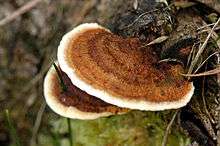Gloeophyllum
The genus Gloeophyllum is characterized by the production of leathery to corky tough, brown, shaggy-topped, revivable fruitbodies lacking a stipe and with a lamellate to daedaleoid or poroid fertile hymenial surfaces. The hyphal system is dimitic to trimitic. The genus is further characterized by the production of a brown rot of wood.[1][2] Phylogenetically, it along with several other brown rot Basidiomycota, Neolentinus, Heliocybe, and Veluticeps form an order called the Gloeophyllales.[3][4][5][6]
| Gloeophyllum | |
|---|---|
 | |
| Fruiting bodies of the rusty gilled polypore (Gloeophyllum sepiarium) | |
| Scientific classification | |
| Kingdom: | |
| Division: | |
| Class: | |
| Order: | |
| Family: | |
| Genus: | Gloeophyllum P. Karst. (1882) |
| Type species | |
| Gloeophyllum sepiarium (Wulfen) P. Karst. (1882) (as Gleophyllum) | |
| Species | |
|
G. abietinum | |
The most frequently encountered species in the Northern Hemisphere is Gloeophyllum sepiarium,[7] which is commonly found in a dried state on both bark-covered and decorticated conifer stumps and logs, timbers on wharfs, planks on unpainted wooden buildings, wood bridges, and even creosoted railroad ties.
Etymology
The name Gloeophyllum combines "gloeo-" a reference to anything sticky, and "-phyllum", a reference to the lamellae. It is probably a combined reference to the fact the lamellae in the type species, G. sepiarium, and other original species, appeared to be stuck together forming anastomosing bridges, to the point of forming a daedaleoid pattern. There is nothing sticky about the actual fungal fruitbodies. The name was originally spelled Gleophyllum but was soon changed and the current spelling is sanctioned.
Pharmacology
An extract of Gleophyllum odoratum exhibits high inhibitory activity on thrombin and trypsin[8] as well as cysteine protease.[9]
References
- Gilbertson, Robert L. (1981). "North American wood-rotting fungi that cause brown rots". Mycotaxon. 12: 372–416. OCLC 21660849.
- Hibbett, David S.; Donoghue, Michael J. (2001). "Analysis of Character Correlations Among Wood Decay Mechanisms, Mating Systems, and Substrate Ranges in Homobasidiomycetes". Systematic Biology. 50 (2): 215–42. doi:10.1080/10635150151125879. PMID 12116929.
- Hibbett, David S.; Binder, Manfred; Bischoff, Joseph F.; Blackwell, Meredith; Cannon, Paul F.; Eriksson, Ove E.; Huhndorf, Sabine; James, Timothy; Kirk, Paul M.; Lücking, Robert; Thorsten Lumbsch, H.; Lutzoni, François; Matheny, P. Brandon; McLaughlin, David J.; Powell, Martha J.; Redhead, Scott; Schoch, Conrad L.; Spatafora, Joseph W.; Stalpers, Joost A.; Vilgalys, Rytas; Aime, M. Catherine; Aptroot, André; Bauer, Robert; Begerow, Dominik; Benny, Gerald L.; Castlebury, Lisa A.; Crous, Pedro W.; Dai, Yu-Cheng; Gams, Walter; Geiser, David M.; Griffith, Gareth W.; Gueidan, Cécile; Hawksworth, David L.; Hestmark, Geir; Hosaka, Kentaro; Humber, Richard A.; Hyde, Kevin D.; Ironside, Joseph E.; Kõljalg, Urmas; Kurtzman, Cletus P.; Larsson, Karl-Henrik; Lichtwardt, Robert; Longcore, Joyce; Miądlikowska, Jolanta; Miller, Andrew; Moncalvo, Jean-Marc; Mozley-Standridge, Sharon; Oberwinkler, Franz; Parmasto, Erast; Reeb, Valérie; Rogers, Jack D.; Roux, Claude; Ryvarden, Leif; Sampaio, José Paulo; Schüßler, Arthur; Sugiyama, Junta; Thorn, R. Greg; Tibell, Leif; Untereiner, Wendy A.; Walker, Christopher; Wang, Zheng; Weir, Alex; Weiss, Michael; White, Merlin M.; Winka, Katarina; Yao, Yi-Jian; Zhang, Ning (2007). "A higher-level phylogenetic classification of the Fungi". Mycological Research. 111 (5): 509–47. CiteSeerX 10.1.1.626.9582. doi:10.1016/j.mycres.2007.03.004. PMID 17572334.
- Hibbett, D. S.; Binder, M. (2002). "Evolution of complex fruiting-body morphologies in homobasidiomycetes". Proceedings of the Royal Society B: Biological Sciences. 269 (1504): 1963–9. doi:10.1098/rspb.2002.2123. PMC 1691125. PMID 12396494.
- Binder, Manfred; Hibbett, David S.; Larsson, Karl‐Henrik; Larsson, Ellen; Langer, Ewald; Langer, Gitta (2005). "The phylogenetic distribution of resupinate forms across the major clades of mushroom‐forming fungi (Homobasidiomycetes)". Systematics and Biodiversity. 3 (2): 113–57. doi:10.1017/S1477200005001623.
- Garcia-Sandoval, R.; Wang, Z.; Binder, M.; Hibbett, D. S. (2011). "Molecular phylogenetics of the Gloeophyllales and relative ages of clades of Agaricomycotina producing a brown rot". Mycologia. 103 (3): 510–24. doi:10.3852/10-209. PMID 21186327.
- http://www.uoguelph.ca/~gbarron/MISC2004/gloeophy.htm%5B%5D
- Doljak, B.; Stegnar, M.; Urleb, U.; Kreft, S.; Umek, A.; Ciglarič, M.; Štrukelj, B.; Popovič, T. (2001). "Screening for selective thrombin inhibitors in mushrooms". Blood Coagulation and Fibrinolysis. 12 (2): 123–8. doi:10.1097/00001721-200103000-00006. PMID 11302474.
- Mlinarič, A.; Kreft, S.; Umek, A.; Štrukelj, B.; Popovič, T. (2000). "Cysteine proteinase inhibitors screening of fungal species growing in Slovenia". Acta Pharmaceutica. 50 (1): 39–48. INIST:1336079.